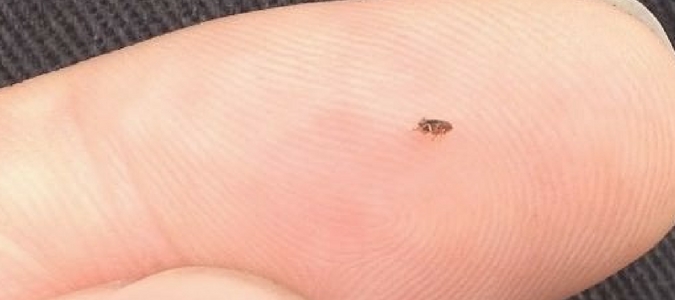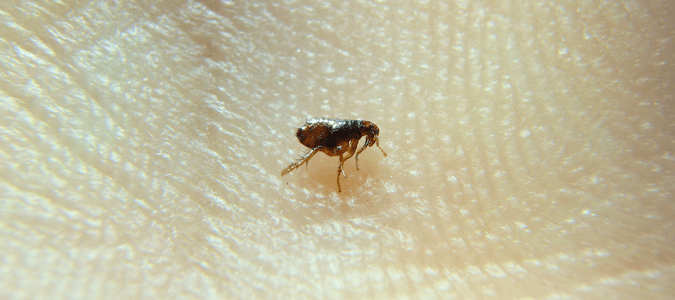
You’re tired of those itchy flea bites on your skin and you know the rest of your family is feeling the same way. Your pets’ constant itching is enough to make you believe that they are also miserable. It feels as if every time you walk across your carpet or sit down on your couch, more bites appear. While you can hop in the shower every time you’re in a flea-infested area of your home, doing so will only get rid of those fleas on your skin. Because fleas prefer dogs or cats, these bothersome pests are more likely to hop off of us and go searching for another creature to feed on.
Additionally, if your flea problem has come to the point where these fleas are biting you, you likely have a full-blown infestation in your home. This means to get rid of fleas on humans, you’re going to have to take a full-property approach and will most likely need to enlist the help of a professional.
To reduce the number of fleas in your home, you can first try the following:
- Vacuum, sweep and mop all of the floors in your home.
- Place all debris into a garbage bag and dispose of it into a trash bin outdoors.
- Steam clean all carpeted surfaces.
- Regularly wash your sheets, pet bedding and pet toys in hot water, then dry these items at the hottest setting.
- Brush your pets with a flea comb outside.
- Take your pets to the veterinarian to be put on a flea control regimen.
Fleas like to nest in the fur of our pets, which is a dark and warm environment. Keep this in mind when trying to address all potential problem areas and make sure to move all furniture when doing your deep cleaning. Many flea infestations affect multiple rooms in a house, which makes some wonder if fleas can fly. Although fleas can jump a surprising distance, most of the time, fleas move around your home by hitching a ride on us or our pets, so you can often find they are dispersed anywhere your pets are allowed to go. Carpet, furniture, pet bedding and indoor plants are all common spots around which to find fleas. Anywhere that your pet likes to sleep or play in is also more likely to have more fleas. Pay attention to these areas as you are trying to manage a flea infestation.
Fleas reproduce quickly, and you can still have fleas in your house, even with no pets. Many times, homeowners ignore the problem or test out a variety of ineffective methods until they have a full-blown infestation. If you’re struggling with a flea infestation, or suspect you have fleas, keep reading for more information regarding these pests, including how to get rid of fleas in your carpet, whether flea bombs are effective and how to distinguish between fleas and another type of bug.

What Is The Fastest Way to Get Rid Of Fleas In Carpet?
Carpets are a common hiding spot for fleas and their eggs. It’s dark, the perfect temperature and they can find a food source relatively easily. These creatures are also capable of staying, for the most part, out of our sight. We may only know fleas are there when we walk across a carpeted area with white socks on and see those little black specks hop on and off our feet. For these reasons, getting rid of fleas in your carpet is going to be a big part of your flea control plan.
Take these steps to get rid of fleas in your carpet:
- Vacuum every inch of your carpeted surfaces. Make sure to move furniture out of the way so you can get into corners. Empty your vacuum bag directly into a trash bag and put it in a bin outdoors.
- Wash your curtains, pet bedding and furniture covers. Curtains are an ideal place for fleas to live and these fabrics are often in areas of the home that are carpeted. Set your washer to the hottest water setting and then dry your curtains on the hottest setting.
- Steam clean your furniture. Fleas can’t survive at temperatures over 95 degrees Fahrenheit, so make sure that you’re getting your steamer nice and hot and spending time going over surfaces thoroughly.
Keep in mind that this process can be time-consuming. To ensure you are getting rid of all of these tiny creatures, which only measure about an eighth of an inch, you’ll need to vacuum once a day and wash your fabrics on a weekly basis. To make matters worse, a female flea can start laying eggs the day after having a blood meal, and she can lay forty to fifty eggs at a time. Depending on environmental conditions, eggs can hatch anywhere from two days to five months, so a flea population can grow quickly and infestations can drag on for an extended period of time. For these reasons, many homeowners opt to contact a pest control specialist after DIY efforts fail.
Speaking of do-it-yourself pest control, many homeowners purchase flea bombs if they suspect they have an infestation. But, do these devices actually work?

Do Flea Bombs Work?
Flea bombs are appealing to many people because they appear to be a quick solution. Just set one off, and all the fleas on your property will be dead, right? Well, in reality, there are a number of problems with flea bombs.
First, when adult fleas sense the fog coming in from these bombs, they are likely to scurry away into deep cracks and crevices where the mist does not reach. There, your resident fleas can wait out the bug bomb and return later, ready to reproduce and prolong your infestation.
Even if your bug bomb does kill the adult fleas, flea cocoons will be unaffected, waiting to hatch. All of the pest control products currently on the market are unable to penetrate these cocoons, which is why an effective pest control approach will target these pests in subsequent life stages. Since flea cocoons can lay dormant for up to five months, without a thorough and effective treatment plan, you could be vulnerable to a reinfestation.
Don’t forget that when you set off these flea bombs, they don’t just target areas where fleas are nesting. These chemicals can also leave a residue on the surfaces of your furniture, carpet, counters and tables, all areas you and your family members commonly use.
Unfortunately, flea infestations can become a problem when homeowners don’t know how to distinguish between flea eggs and dandruff.

Flea Eggs Or Dandruff? How To Recognize Signs Of Fleas
Flea eggs are visible to the human eye. Unfortunately, eggs may be mistaken as pet dandruff at first glance. Some pet owners fail to remove fleas because they think their pet just has flaky skin. Flea eggs and dandruff may both appear in your pet’s fur, and both can be a fraction of an inch, but there are some key differences between the two.
Flea eggs tend to be more consistent in size and shape, while dandruff comes in all shapes and sizes. Dandruff is also pretty sticky, and tends to stay awhile in your pet’s fur. Flea eggs will easily fall off and land on the carpet, furniture or on your pet’s bed.
If you suspect that your pet has fleas or dandruff, reach out to your veterinarian. Veterinarians can tell you what’s on your pet and offer you suggestions on what you can do, which may include using a specially-formulated shampoo to use to kill fleas, a flea comb to remove eggs or a plan of action to deal with dandruff. Vets can also recommend preventative medicine and measures that will keep fleas off of your pets while they spend time outside or come into contact with other dogs. Prevention is a key part of keeping fleas out of your house and off of your pets.
Since fleas are so tiny, they are sometimes mistaken for another type of creature: mites.

Flea Vs. Mite: What’s In My Home?
Fleas aren’t the only pest that can become a nuisance. Flea bites are sometimes mistaken for mite bites. Another common mistake homeowners make is confusing bed bug bites and flea bites. In most cases, however, fleas are the culprit. Bed bug bites tend to appear around your arms, neck, hands and face—all areas which are exposed when you are sleeping.
Being able to identify these tiny creatures and their bites plays a critical role in determining next steps.
What Do Fleas Look Like?
Once a flea egg has hatched, it will grow into an adult, as pictured above. You can identify a flea by the following characteristics:
- 1/8 inch long
- Brownish-black in color
- Oval-shaped
- Wingless
- Hexapods (have six legs)
Fleas can look like small black pepper flakes, which means that they’re easiest to see when in the fur of a light-colored pet or hopping around your home or lawn. Flea bites are small, itchy, red circles and are commonly found around your feet and ankles. While you won’t often see flea bites on pets, you may notice your dog or cat scratching more often if you have a flea problem. However, skin irritation can be linked to other conditions, and not all pets experience flea bite dermatitis or severe symptoms.
What Do Mites Look Like?
If you see something that you suspect may have bitten you, it’s probably not a mite. Mites are often invisible to the naked eye, averaging about a tenth of an inch in length and often lighter in color than fleas. They typically don’t survive indoors, although they can bite us. Unfortunately, even mite bites are hard to spot, as they typically look like a big, red rash.
Most likely, it will be obvious from other signs that you have a flea infestation. Bites will appear around your ankles and your pets will seem uncomfortable. Fleas are also visible to the human eye and you may see them jumping around the house or in the teeth of your pet’s flea comb. However, if you’re still not sure what kind of pest you’re dealing with, the best option is to contact the pros.
ABC Can Resolve Your Flea Problem
Having fleas can be exhausting, as these pests reproduce quickly and can hide in tiny cracks and crevices. If you are ready to get your flea problem under control, your best option is to turn to the pest control professionals at ABC Home & Commercial Services. With over 70 years of experience in the pest control industry, our skilled technicians know exactly how to target these pests so that your problem is soon a thing of the past.
